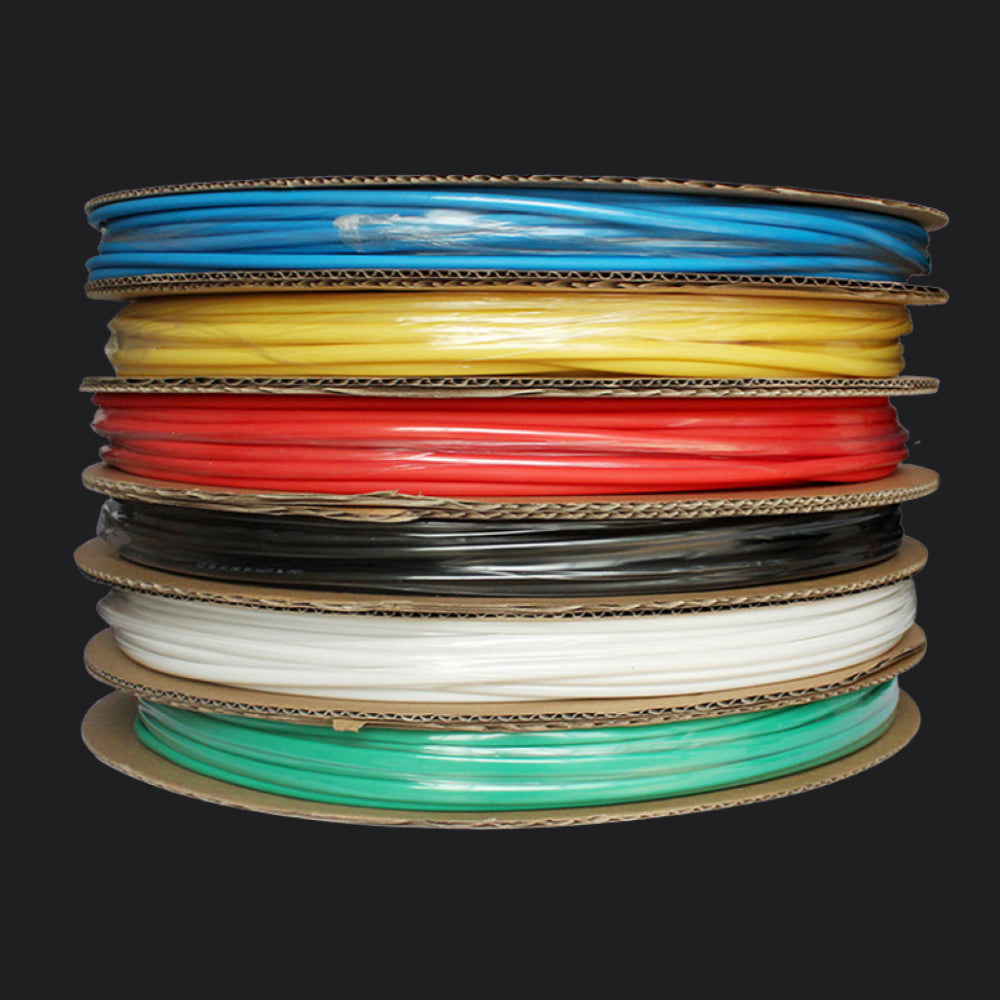
2:1– Heat shrink Tubing will become half of its original size when heat is applied. Another way to look at the ratio is that the original size will be twice as large as its shrunken form.
3:1- Heat Shrink Tubing will become one third of its original size when heat is applied. Another way to look at the ratio is that the original size will be three times as large as its shrunken form.
4:1- Heat Shrink Tubing will become one quarter of its original size when heat is applied. Another way to look at the ratio is that the original size will be four times larger than its shrunken form.
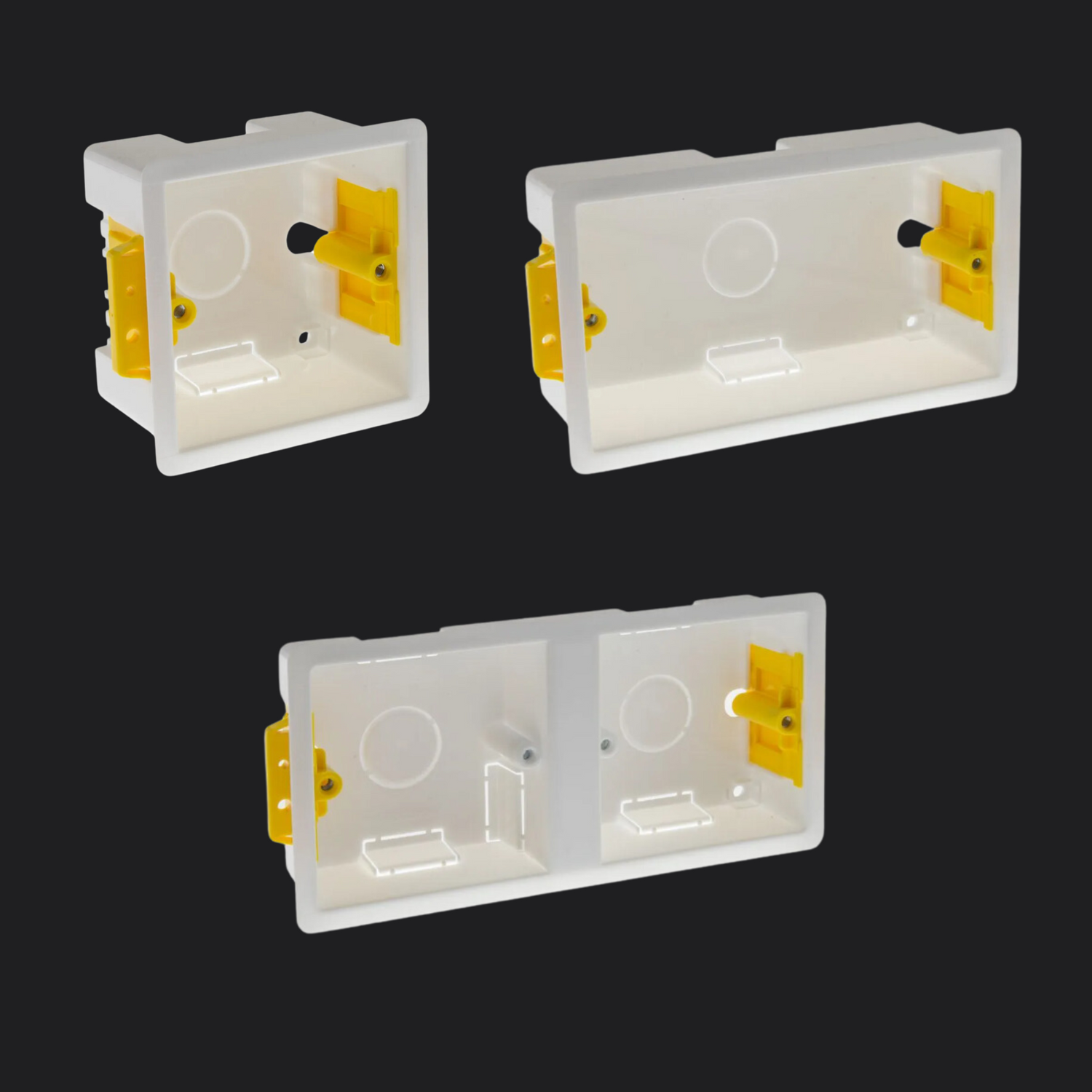
Electrical - Dry Lining Back box
Browse our stock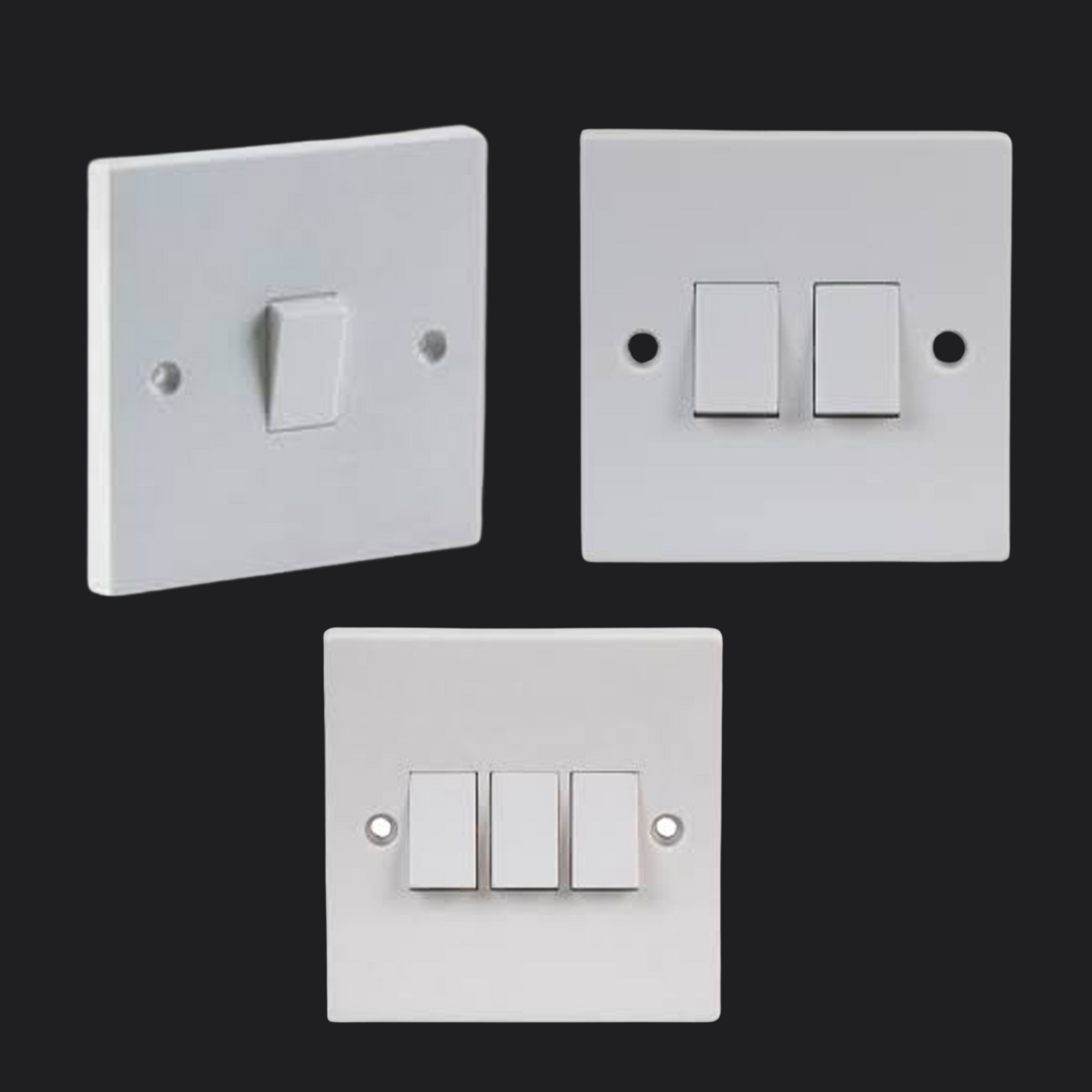
Electrical Switches
Browse our stock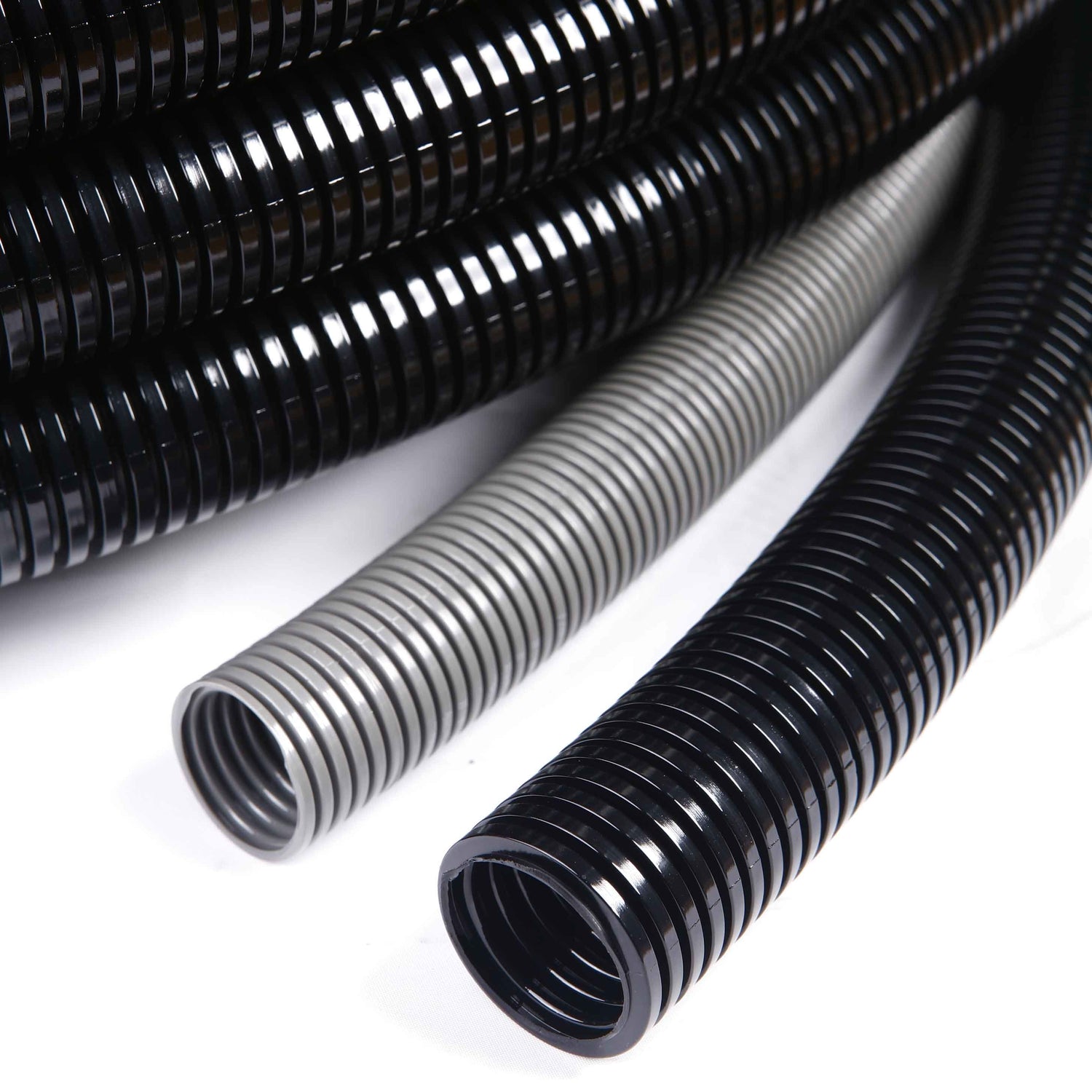
Flexible Conduit
Browse our stock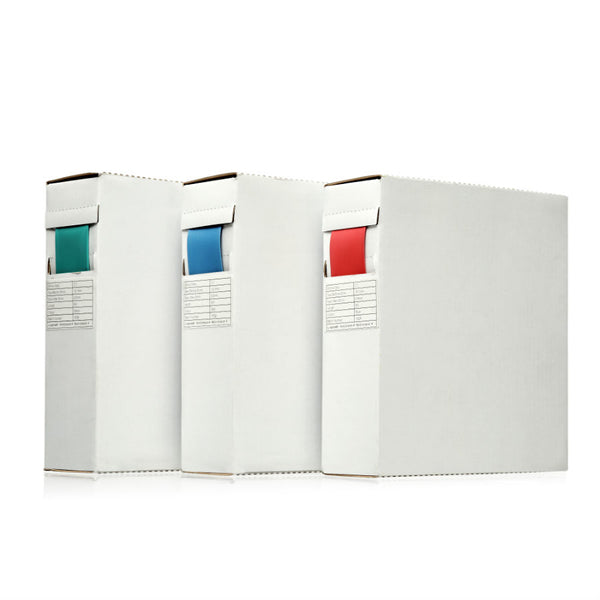
Buyers Guide
Collapsible content
Cable Ties
What are Cable Ties Used for? The Different Types of Cable Ties & When to Use Them
What are cable ties used for, how many types of cable ties are there, and what are the best cable ties?
Choosing the best cable tie will depend on several factors, including what they will be used for, where will you be using them and how many times will you need to use them.
With so many options to choose from, across a range of types, sizes, materials, bundle diameters, tensile strengths, operating temperatures and so on, it can be daunting when choosing the right cable tie for the task.
Over the next few articles we will unpack the jargon and break down everything you need to know when deciding which solution is best for you.
What are cable ties used for?
It’s highly likely that you will have used a cable tie at one point or another in time.
Cable ties are one of the most versatile products on the planet, used across a wide variety of different applications from home and garden to large-scale commercial and industrial projects. Our customers use cable ties for anything from attaching signage to posts to securing pipes on oil rigs. We happily cater for everyone from keen gardens who need to secure plants to canes or plumbers that need to label different pipes with different colour ties.
Cable ties can be referred to in several different ways, including:
- Cable ties
- Zip ties
- Tie wraps
- Ty wraps
Cable ties bundle together cables and wires (amongst other things) together to keep them organised, secure and safe.
Best Tape For Outdoors
Which tapes are best for outdoor use?
There are lots of types of tape which can be used outdoors, but some are more durable and water resistant than others.
It’s important that tape used outdoors is designed to withstand the elements, including UV rays, hot weather, wind, rain and freezing temperatures.
Duct tape is an ideal tape to use outdoors. It is a heavy duty tape used for binding, fixing things securely and making repairs.
Made with incredibly strong polycloth material and an adhesive coated with a synthetic rubber, it performs in some of the most extreme weather conditions.
It is water resistant and can cope with temperatures from well below freezing (-15°C) to heat of up to 70°C, meaning it can withstand the rays from the sun on the hottest days.
Duct tape has the strongest adhesion out of all tapes, so is suitable for use in all types of weather.
Our Duct Tape Buyer’s Guide answers other frequently asked questions about duct tape.
PVC electrical insulation tape
PVC electrical tape can also be used outdoors, due to its material. It is manufactured using premium grade plasticised PVC film. It is mainly used by electricians to apply insulating protective jackets to cables, wires, as well as labelling and making repairs.
It is designed to withstand the elements, is UV resistant, flexible and has good protection against abrasion. It has a wide temperature rating, from -18°C to +105°C and is also self-extinguishing in fires.
PVC electrical insulation tape is not waterproof but it does provide some protection against moisture. It needs to be applied in half-lapped layers to provide the ultimate protection.
Our PVC Electrical Insulation Tape Buyer’s Guide answers other frequently asked questions about PVC tape.
Silicone Tape
Silicone tape is a weather resistant tape used to waterproof joints or make temporary repairs to leaking pipes. It is made of self-fusing silicone rubber and is UV resistant. It has an operating temperature range, going from -20 °C to an incredible 250°C.
Our self amalgamating waterproof tape is ideal for outdoor use. Its clever design and ethylene propylene rubber material means that it bonds to itself to create a watertight seal around leaking pipes and joints. It has a continuous temperature rating of 90°C, and an overload temperature rating of 130°C.
This high quality tape uses no glue. Once stretched and wrapped around the object which needs repairing, the tape fuses to itself. It has to be applied with a 50% overlap as it only bonds to itself. Our self amalgamating waterproof tape is also resistant to chemicals.
Warning barrier tape
Warning barrier tape is a highly-visible tape used for marking or cordoning off areas, both inside buildings and outdoors. It is a simple, quick and cost-effective way to highlight hazards and is mostly used by facility managers, construction site workers and emergency services.
It is durable in most weather because it’s made of polyethylene (PE) film and is non-adhesive. It also has a tensile strength of 6 N/cm, so can resist strong winds. However, it is not rated to withstand temperatures below freezing (from 0°C to 60°C).
Duct Tape Uses
What is duct tape used for? What are the different types of duct tape?
Duct tape is the go-to heavy duty tape for making household repairs, securely fixing things to surfaces and many other practical uses. An essential addition to every tool box, it is strong, highly adhesive and versatile.
Our buyer’s guide will help you decide which duct tape you need.
What is duct tape?
Duct tape is a highly adhesive, water-resistant tape which can be used for an almost limitless number of purposes.
It is made of a strong polycloth material which sits between a synthetic rubber layer and a coloured backing (often silver). The combination of the cloth and backing is what gives duct tape its strength and durability.
What is duct tape used for?
Duct tape is used in industries from TV, film and music production, to manufacturing, logistics, heating and air ventilation, for household repairs and more.
It has many practical uses around the home and in professional environments, including:
- Patching holes
- Packing boxes
- Sealing joints
- Waterproofing
- Strapping
- Asbestos removal
- Fixing cables to the floor
- Repairing broken windows
- Colour-coding
- Repairing car upholstery
There are some other, more unusual but practical uses for duct tape that you may not have heard of:
- Removing splinters
- Removing lint and fluff from clothes
- As insulation in boot insoles
- Protecting floors from furniture
- Making a bandage
Who invented duct tape?
Duct tape has a long history, but the tape that is generally referred to as duct tape today was invented by Vesta Stoudt in World War II. Vesta proposed that ammunition boxes could be sealed with a waterproof tape to protect the contents better.
She came up with the idea of using a tearable, waterproof, cloth-based tape. President Franklin D. Roosevelt approved the invention and Johnson & Johnson manufactured it. It was originally called ‘duck’ tape because it repelled water ‘like a duck’s back’.
What are the different types of duct tape?
Duct tape comes in a variety of colours, lengths and widths. We sell premium, wide and extra wide duct tape in colours including red, white, silver/grey and black.
The premium tape is a higher quality duct tape, while the wide and extra wide tapes are more useful for applications where you have a bigger surface area to cover.
Premium (Red, white, silver, Black, Silver, Yellow)
This premium grade, heavy duty duct tape is ideal for binding, repairs and securely fixing things onto surfaces due to its strong adhesive coating.
- Strong adhesive coating with vacuum hotmelt (synthetic rubber).
- Leaves no residue.
- Water resistant.
- Suitable for indoor and outdoor use.
Size: 48mm x 50m (50 mesh - 0.18mm thick)
Which duct tape is strong?
All duct tape is designed to be strong. Our tape has a tensile strength of >60N/cm and is adhesive to steel up to 6 N/cm.
Does duct tape leave a residue?
Our range of duct tape has been designed to leave no residue, so you don’t need to worry about cleaning off any remnants of sticky adhesive.
Is duct tape conductive?
Duct tape made of polycloth and coated with plastic is non-conductive, which means in theory it can be used to insulate electrical wires. However, we always recommend you use PVC electrical insulation tape to do this because it is specially designed for the job.
Is duct tape heat resistant?
Our duct tape has a temperature rating of -15°C to 70°C.
Is duct tape and electrical tape the same?
No, duct tape and electrical tape are different. Duct tape is designed to fix or hold things together, while electrical tape is a specialist tape used by electricians for insulating and identifying cables and wires.
Are duct tape and gaffer tape the same?
Duct tape and gaffer tape are slightly different. Gaffer tape is a heavy, cotton cloth tape with strong adhesive qualities, and it doesn’t leave a sticky residue. Duct tape is a cloth tape which has a synthetic rubber adhesive on one side.
Which duct tape should I buy?
It depends which job you need to do and how big the surface area is that you need to cover.
Our premium tapes have excellent adhesion for both indoor and outdoor use, so they are ideal for jobs needing more of a long-term solution.
Other types of tape and their uses
- Hazard tape - For marking floors, walls and obstructions in buildings
- Aluminium tape - Ideal for creating airtight and watertight seals on pipes
- Packaging tape - Use to pack parcels and boxes
- Silicone tape - For waterproofing joints and making temporary repairs to leaking pipes
- Decorating masking tape - Use to protect surfaces when painting
- PVC tape - For insulating electrical cables and wires
PVC Electrical Tape
What does electrical tape do? What is electrical tape made of?
Electrical tape is used mainly for insulating and repairing damaged or cut cables and wires. It’s used in many applications, from home DIY to commercial wiring installations and repairs.
When choosing the right electrical tape for the job, there are several things you need to consider.
Read on to find out more about the different types of electrical tape, how to use it and more.
What does electrical tape do?
Electrical tape insulates wires to stop them conducting electricity, prevent electric shocks and reduce fire hazards. It protects cables and wires from the elements to stop abrasion, corrosion and UV damage. It also provides protection from chemicals including acids and alkalis.
It’s also used to keep wires and cables tidy, organised and easily identifiable. It’s most commonly used by electricians.
What is electrical tape made of?
Electrical tape is made of PVC (polyvinyl chloride), a highly versatile polymer that does not conduct electricity. It is also very flexible, which makes it ideal for use in electrical tape when wrapping around cables.
Why is it called electrical tape?
The full, technically-accurate name for electrical tape is PVC electrical insulation tape. It was given this name because of its material and how it’s used.
When was electrical tape invented?
Electrical tape was invented more than 75 years ago by American inventors Snell, Oace, and Eastwold from The 3M Company. Before they created PVC electrical tape, electricians were using tape made of cotton, which was weak and unreliable for the job it needed to do.
What is electrical tape used for?
Electricians use PVC insulation tape when adding new installations, or for making repairs.
It’s mainly used for:
- Protective jacketing
- Insulating wires, cables, connections and connectors to stop them from conducting electricity
- Making repairs to damaged cable sheathing
- Harnessing and bundling cables together
- Sealing and marking cables for identification
Some quirky uses for electrical tape
There are some surprising and unusual uses for electrical tape, including:
- Football teams use electrical tape to hold up their socks and keep shin pads in place
- To protect hockey sticks from moisture build up
- Making drumsticks more durable, to prevent slippage and splinters
- For repairing holes in tents when camping
- Marking where actors should stand in theatre and film productions
- Arts and crafts projects
Is PVC tape waterproof?
PVC electrical insulation tape is not waterproof but it does provide some protection against moisture. Electrical tape can’t be fully waterproof because it’s sticky surface would lose adhesion if it became too wet.
Can electrical tape be used outdoors?
You can use electrical tape outdoors because it is durable, robust and designed to withstand the elements. But it is not guaranteed to keep water out over the long term because it is water-resistant, not waterproof.
What are the different types of electrical tape?
Electrical tape comes in a variety of colours, lengths and widths.
The different colours of electrical tape are related to the voltage and phasing of the wires, and their usage depends on the standards of the country. Grey, brown, white and green and yellow striped tape are not used as commonly in the UK as they are internationally.
The table below shows the features, technical information and usage of each tape.
Is PVC tape strong?
PVC electrical tape has tensile strength of 22 N/10mm and dielectric strength of 40kV/mm. It can also stretch to 125% of its length.
When wrapping cables, stretch the tape as you go to help it stick better. Use enough tension when applying the tape to make sure it conforms evenly to the surface of the cable. This will provide better insulation than if there is any slack in the tape. Trim the tape and press down the end to avoid the tape lifting.










